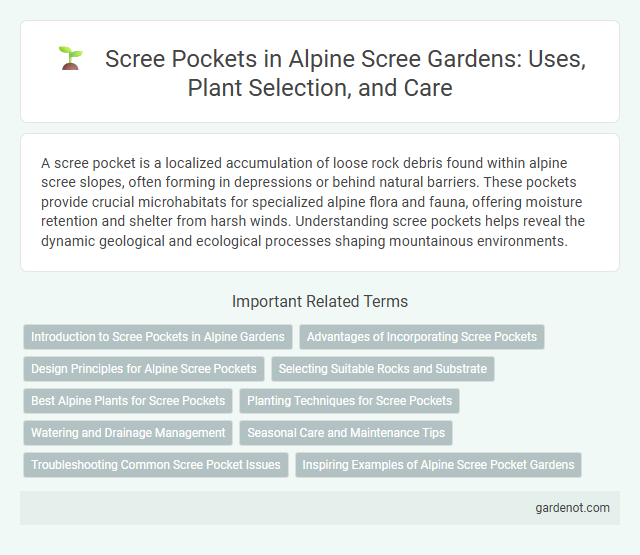A scree pocket is a localized accumulation of loose rock debris found within alpine scree slopes, often forming in depressions or behind natural barriers. These pockets provide crucial microhabitats for specialized alpine flora and fauna, offering moisture retention and shelter from harsh winds. Understanding scree pockets helps reveal the dynamic geological and ecological processes shaping mountainous environments.
Introduction to Scree Pockets in Alpine Gardens
Scree pockets in alpine gardens are specialized microhabitats formed by accumulations of loose rock fragments that provide excellent drainage and mimic natural mountain environments. These pockets create unique conditions ideal for cultivating alpine plants adapted to harsh, rocky terrains with minimal soil. Their well-drained, nutrient-poor substrate supports species such as saxifrages, alpine asters, and cushion plants that thrive in cool, exposed settings.
Advantages of Incorporating Scree Pockets
Scree pockets enhance soil drainage and prevent waterlogging by capturing loose rock fragments, creating a natural filtration system that supports alpine plant stability. These pockets improve microhabitats for specialized flora and fauna, increasing biodiversity in harsh mountainous environments. Incorporating scree pockets into alpine landscaping reduces erosion and maintains slope integrity, promoting long-term ecological resilience.
Design Principles for Alpine Scree Pockets
Scree pockets in alpine environments are designed to stabilize loose rock debris while promoting natural vegetation growth, reducing erosion risks on steep slopes. Key design principles include selecting suitable rock sizes to enhance interlock and drainage, optimizing slope angle between 30-40 degrees for stability, and incorporating native plant species with deep root systems to anchor the substrate. Effective scree pocket designs balance mechanical support with ecological restoration, ensuring long-term slope resilience and habitat preservation.
Selecting Suitable Rocks and Substrate
Selecting suitable rocks and substrate for a scree pocket involves evaluating angular, well-drained rocks such as granite or basalt that create stable microhabitats. The substrate should consist of coarse, mineral-rich gravel mixed with sandy soil to ensure proper water drainage while retaining moisture for alpine flora. Proper placement and layering enhance root anchorage and protect plants from erosion and frost heaving in high-altitude environments.
Best Alpine Plants for Scree Pockets
Best alpine plants for scree pockets include species like Saxifraga, Sedum, and Helianthemum, which thrive in well-drained, rocky environments with minimal soil. These plants exhibit drought tolerance and compact growth, making them ideal for creating vibrant, low-maintenance scree pockets that mimic natural alpine conditions. Their deep root systems stabilize loose scree, preventing erosion while providing striking seasonal color and texture.
Planting Techniques for Scree Pockets
Scree pockets require specialized planting techniques that prioritize well-drained, gritty soil to mimic natural alpine conditions. Utilizing rock fragments mixed with coarse sand enhances drainage while anchoring roots securely against erosion. Selecting drought-tolerant alpine plants adapted to minimal nutrient availability supports successful establishment and growth in these microhabitats.
Watering and Drainage Management
Scree pockets require precise watering strategies to prevent waterlogging, as excessive moisture disrupts root oxygen availability and destabilizes the loose substrate. Effective drainage management involves installing permeable layers or drainage channels to facilitate rapid water runoff while retaining necessary hydration for alpine plants. Optimizing moisture control in scree pockets supports plant health and prevents erosion within fragile alpine ecosystems.
Seasonal Care and Maintenance Tips
Scree pockets require seasonal care tailored to drainage and plant stability, ensuring sediment does not accumulate excessively during snowmelt and rain. Regular inspection for soil erosion and removal of debris maintains optimal conditions for alpine vegetation growth. Proper seasonal maintenance preserves the delicate balance of scree ecosystems and prevents structural damage to the surrounding terrain.
Troubleshooting Common Scree Pocket Issues
Scree pockets often suffer from drainage problems causing water accumulation and plant root rot. Stabilizing loose stones using geotextile fabric prevents erosion and maintains structural integrity. Regular inspection for sediment buildup and clearing debris ensures optimal water flow and promotes healthy alpine vegetation growth.
Inspiring Examples of Alpine Scree Pocket Gardens
Scree pocket gardens in alpine environments showcase remarkable biodiversity by thriving in rocky, nutrient-poor substrates where traditional soil is minimal. These microhabitats support specialized plant species such as alpine saxifrages, moss campion, and edelweiss, which adapt to extreme conditions with resilience. Innovative designs replicate natural scree conditions, inspiring sustainable landscaping that enhances erosion control and promotes endemic flora conservation in high-altitude regions.
Scree pocket Infographic

 gardenot.com
gardenot.com